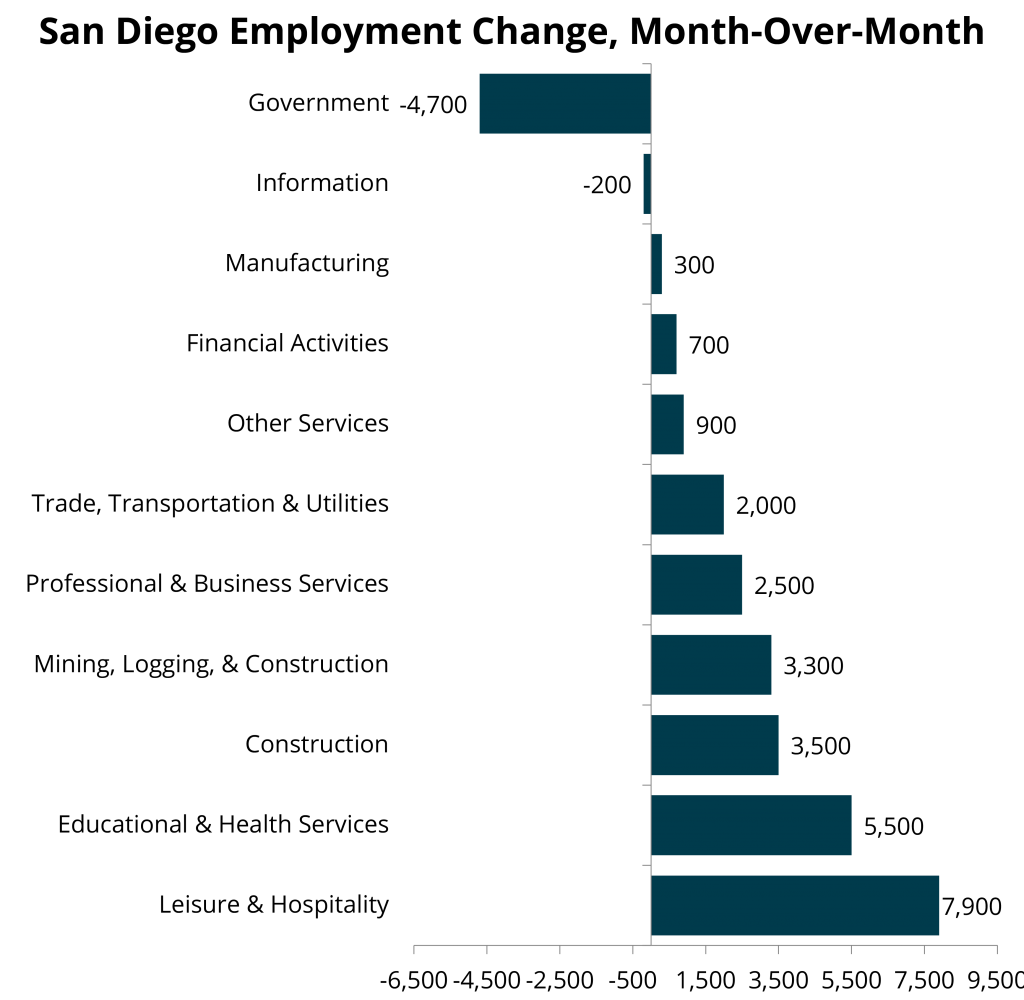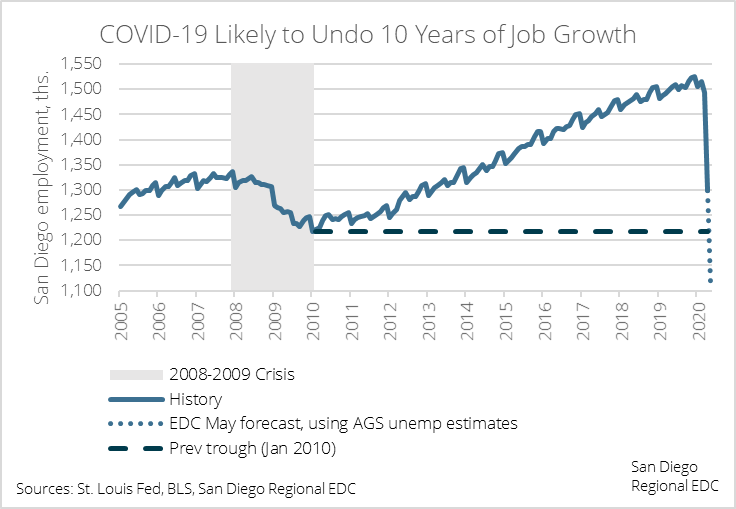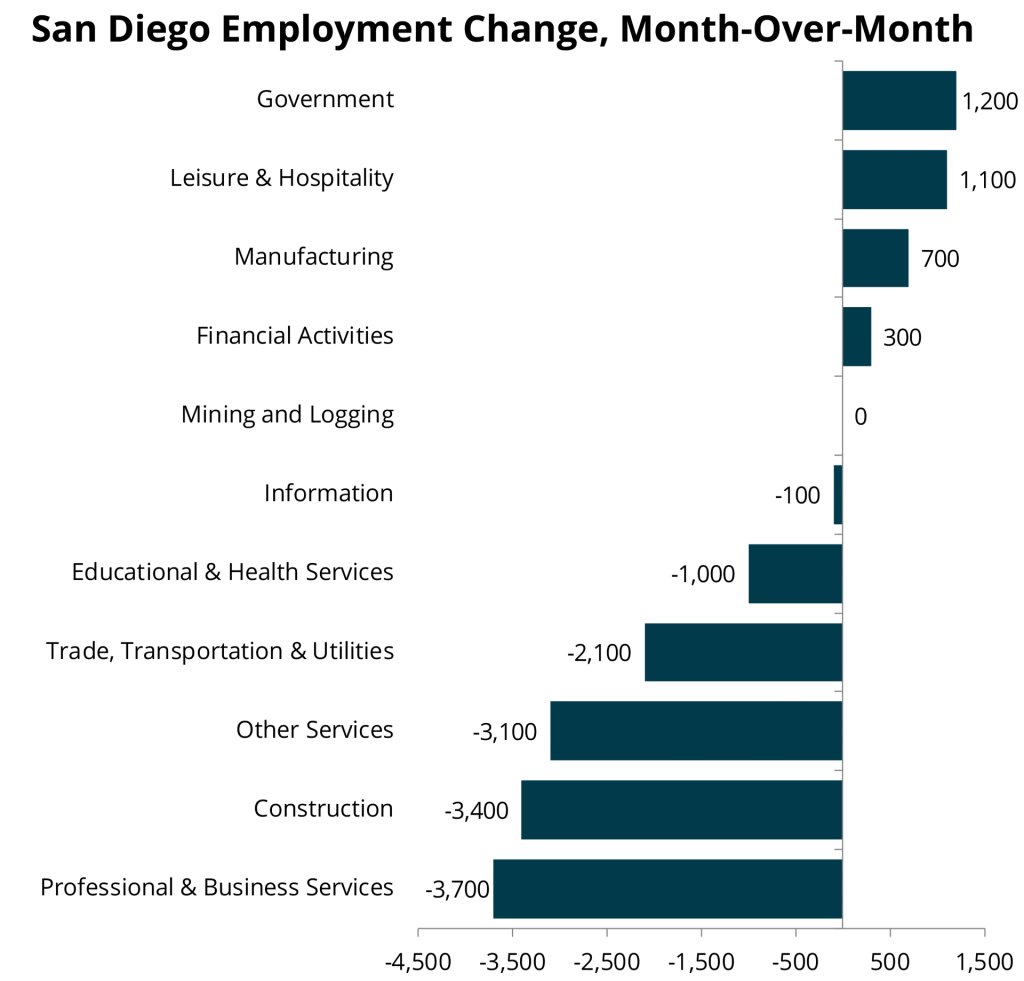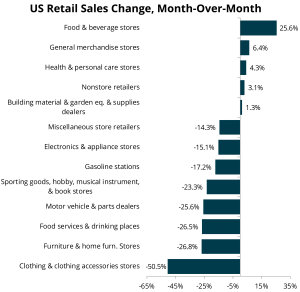Earlier this year, we deployed a survey to assess the immediate economic impacts and evolving business sentiment in the wake of COVID-19.
To assess changes over time, we have deployed a follow-up survey with our partners at San Diego Regional Chamber of Commerce, San Diego and Imperial Small Business Development Center. The Downtown San Diego Partnership and National City Chamber of Commerce also served as survey partners. Information collected was from May 28 – June 8 and includes 194 valid responses.
Three trends stood out based on what employers told us:
- Anticipated revenue declines and staff reductions confirmed by businesses; 41 percent of businesses surveyed saw revenues decline by 81 to 100%, 93 percent saw staffing declines of one to 50 employees.
- Minority owned businesses are hardest hit but may lead recovery. Long term, minority owned businesses anticipate continuing workspace changes (56 percent), teleworking (41 percent), offering online services (34 percent), and virtual programming and team building.
- Telework is here to stay, with 47 percent of firm surveyed reporting workspace changes to continue after the state of emergency is over.
Understanding COVID-19’s impact: an interactive visualization
Below is an interactive visualization of self-reported impacts to local employers, both in terms of employment and revenue. You can segment the data by industry, number of employees, and typical annual revenue. Additionally, please scroll over the tab to look at the breakdown of responses via zip code. Please note, this is not a representative sample – meaning we did not weigh responses operationally to the population and demographics of the region – so we strongly advise against drawing sub-regional conclusions from this data.
Survey Overview
The economic impacts of this crisis disproportionately affect the parts of our community that are disconnected from growth: communities of color and small businesses. The right recovery means focusing on efforts that benefit all San Diegans in this unique moment in time.
The overwhelming majority of firms surveyed (93 percent) were small businesses (fewer than 100 employees) and most (73 percent) had revenues of less than $1 million in 2019. Survey respondents were concentrated in the food and beverage, professional services, manufacturing, and retail industries.
Nearly 93 percent of firms surveyed saw their revenue decline, with most (41 percent) declining by 81 to 100 percent. However, more than one third expect revenues to return to 2019 levels in six to 12 months. The majority cut back on payrolls, with nearly 74 percent reducing staff hours and 60 percent reducing staff. The food and beverage industry had the most (19 percent) full time layoffs, followed by professional services (17 percent). Overall, most firms in all industries expect layoffs to be temporary, but 32 percent are still unsure. The uncertainty might be due to growing concern that the economy will fully reopen within the coming summer months, but a second wave in the fall will turn temporary layoffs into permanent ones.
Nearly 87 percent of firms surveyed applied for government (federal, state, or city) or private (company grants or bank loans) funding, and 70 percent who applied received funding. Firms that received private (company grants or bank loans) funding received more than $260,000 on average and firms that received government funding received more than $245,000 on average
Firms located in the opportunity zone represent 12 percent of survey respondents, or 24 businesses. In terms of access to capital, nearly 63 percent of firms located in an Opportunity Zone cited access to capital as a long term need in response to COVID-19, while 43 percent of all survey respondents cited access to capital as a long term need.
When asked about the changes a firm has experienced as a result of the pandemic, the top response was “scope of work”, which indicates firms are adjusting their business models and changing the range in which they operate in response to COVID-19. Unsurprisingly, in the short-term, businesses’ greatest needs are increased revenues and additional capital. While many businesses are unsure of the longer-term impact, they still anticipate needing capital and replacing staff.
Anticipated Revenue Declines and Staffing Reductions Confirmed
Most anticipated revenue impacts in the beginning of the COVID-19 pandemic were realized, even as reopening continues across San Diego County. More than 95 percent of businesses surveyed that expected their revenue to decline saw an actual decline in their revenue. Nearly 97 percent of businesses that expected their revenue to decline by 81 to 100 percent saw an actual decline of that amount.
Most anticipated staffing impacts in the beginning of COVID-19 pandemic were realized as well. More than 73 percent of firms surveyed who anticipated staff reductions actually reduced their staff. Most staff reductions were between 1 and 50 employees. More than 78 percent of those that anticipated staff reductions of one to 50 employees actually saw these reductions.
Minority-Owned Businesses
A new report shows that because minority owned small businesses have been disproportionately impacted by COVID, they may demonstrate how US businesses will ultimately adapt. These businesses are experimenting with new ways of working to ensure their employees’ safety, offering relief to employees and community members, and introducing new services. In San Diego, the top adjustments minority owned businesses made in response to the pandemic that are working well are workspace changes (56 percent), teleworking (41 percent), offering online services (34 percent), and virtual programming and team building.
There were 44 minority owned businesses that responded to the survey. Nearly all (98 percent) of minority owned businesses surveyed were small businesses with fewer than 100 employees. These businesses are concentrated in professional services, food and beverage, manufacturing, and retail – the industries hardest hit by COVID-19. The latest employment data shows that from February to June 2020, local retail, food and beverage, and professional services lost a combined 86,200 jobs. More than 90 percent of minority owned businesses have seen their revenue decline, with most experiencing steep revenue declines of 81 to 100 percent.
Workspace Future
In order to keep operating, many businesses have made changes to their physical workspace and/or are have employees working remotely. Firms surveyed expect to maintain these arrangements even after the state of emergency is lifted. Nearly 76 percent of firms surveyed report physical space as critical for operation, with most of those businesses in food and beverage, professional services, and manufacturing. Only seven percent of firms reported the pandemic has shown them that office space is unnecessary. Firms were split in regards to whether physical workspace will decrease, increase, or remain the same in the future.
Resources for you
San Diego Regional EDC, San Diego Regional Chamber of Commerce, and San Diego and Imperial SBDC offer a variety of resources to help businesses.
If you would like assistance from EDC, please use this form. Once we receive your responses, we will make every effort to reach out to you within 24 hours.




